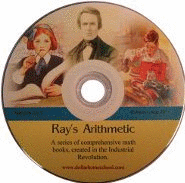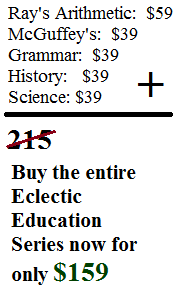|
Dollar
Homeschool Bringing Back American Education |
|
|
||||
Eclectic Education
Series The Homeschool
Blog The Homeschool
Blog |
How to begin or maintain a home school. It can be a seemingly overwhelming task just to begin setting up a homeschool, and the number of possible books and programs available is huge. What I would like to do in the next few pages is to provide you with a basic structure for a successful homeschool which will hopefully break down the task into a more manageable one.
First of all, something which has been said many times before but which bears repeating is to keep it simple. Especially when just starting out or when working with young children it is important to have a daily routine which is very short and to the point. Our family used the Robinson Curriculum when I was growing up, and the daily routine proposed by Dr. Robinson was very succinct.
And that was it. It comes to a little over 5 hours of study. By accomplishing this short list of study each day your child is assured to be at the very least at his grade level, and will often go far beyond in areas that he/she enjoys.
Now there is nothing sacred about this formula, and it could often be changed and modified to fit a particular student or other activities, for instance a younger child might do copy work from the McGuffey Readers instead of original writing, or do only an hour of math or reading instead of the full 2 hours.
This basic routine provided the setting necessary for a student to know exactly what was required of him each day, which is a powerful tool for a homeschool mom who often doesn't have the time necessary to give her older children 1 on 1 teaching while also teaching the younger children and taking care of other household duties.
Another benefit of keeping to a simple routine is that it gives large blocks of time to the basic 3 study groups: Reading, Writing and Arithmetic. Jumping from one subject to another can be distracting, and it can take some time simply to let the students brain settle in and begin thinking about the new material.
The best way a student can learn and remember what he studies is to engage his mind by doing what is called 'Active Learning”. Active learning is where the student is actually applying his mind, by attempting to solve math problems, write an essay, taking notes while reading or otherwise actively getting and applying information on his own. The opposite of Active Learning is Passive Learning, for instance reading a book without taking notes, or watching an educational video. Not all passive learning is bad or useless, but it should be saved until after the active learning has been done. This is why reading for two hours was the last part of the routine we set for our day.
A great resource for quality educational books for your homeschool is the Eclectic Education Series, a collection of books which provided Americans with some of the best educations in the world, before John Dewey and the demise of American education. Click Here to learn more. |
 |
|
|
|
|
|
|
|
|
|
|
|
|
|
|
|
 |
|||||||
|
|||||||
|
|||||||
|
|||||||
© Copyright Dollar Homeschool, 2009. All
Rights Reserved.